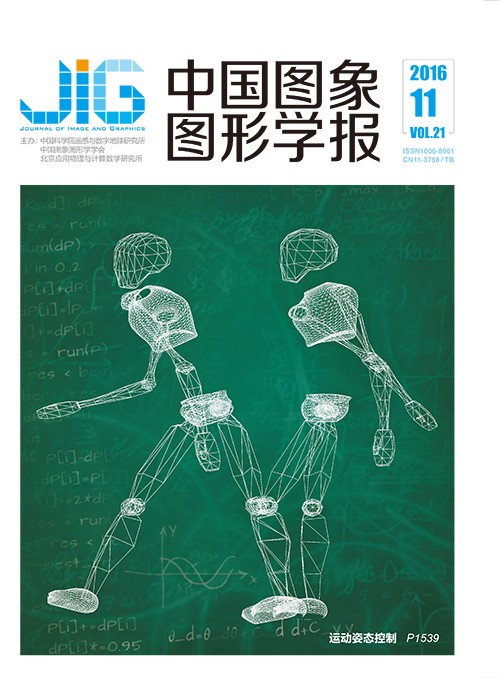
基于高斯模型的手部肤色建模与区域检测
摘 要
目的 随着市场需求的多样化和多变性的加剧,对于生产装配的柔性和适应性提出了更高要求,人机合作装配为应对当前需求提供了有效方法。在人机交互协调的机械装配系统中,为有效实现机器人对操作人员手部装配动作的识别和理解,需对手部装配图像进行生物结构的特征检测。针对人机交互协调装配中的手部肤色图像识别问题,提出一种基于多色彩空间信息的识别算法。方法 基于聚类思想,通过离线学习与期望最大化算法,在RGB色彩空间上对肤色信息建立多混合高斯模型,以此获得肤色信息的多混合聚类表示。再利用YCrCb色彩空间上的稀疏化高斯模型在线快速学习肤色分布,设计了基于多色彩空间信息的肤色识别器。结果 图像照度对肤色区域的模型似然值有较大影响。在线稀疏化学习肤色识别实验结果显示,YCrCb 3通道上学习获得的似然值不存在严重冗余,所建模型与对应的学习框架有效,结合多色彩空间的识别信息确认了肤色区域。肤色区域初始化识别的完整性与在线学习算法的时间复杂度有关,识别过程中模型参数的更新量与场景光照均衡度有关,进而影响算法的空间复杂度。本文基于高斯模型的手部肤色建模与区域检测方法对于机械装配环境的手部肤色检测适应性良好,经与改进的YCrCb椭圆聚类模型对比,该方法具有更好的识别完整性。结论 本文算法提高了模型对固定场景下光照畸变的适应度,从而改善了识别效果,但识别算法的收敛时间较长,实时性尚需进一步提高,可在进一步的研究中进行优化。
关键词
Hand skin color modeling and region detection based on Gaussian model
Yang Shiqiang, Gong Luqi(Faculty of Mechanical and Precision Instrument Engineering, Xi'an University of Technology, Xi'an 710048, China) Abstract
Objective The continuous intensification of diversification and polytrope on market requirement has created demand for high flexibility and adaptability of production assembly. Human-computer interaction cooperation in mechanical assembly is an effective way to satisfy the market requirement. The organic texture character of hand skin image in mechanical assembly must be detected effectively. Such detection can in turn determine the capability of the robot to recognize and comprehend the action and behavior of the operator in human-computer interaction cooperation in mechanical assembly. Method A recognition algorithm is presented for hand skin recognition in image based on multi-color space information. The proposed algorithm is used in human-computer interaction coordination in mechanical assembly. A multi-component mixture model of skin color in the RGB color space is established for clustering by the off-line learning method of the Gaussian mixture model and expectation maximization algorithm. The hand skin information is expressed by mixture clustering. Furthermore, the law of skin color distribution in YCrCb color space is studied by on-line fast learning to sparse Gaussian model. The hand skin recognizer is designed based on muti-color space information. Result Image illuminance significantly influences the likelihood value of skin region model. The high threshold value is fitted for high image illuminance region, and low threshold value is fitted for low image illuminance region. Experimental results for hand skin recognition based on on-line sparse fast learning show that the redundance of likelihood in YCrCb three-color space channels is acceptable. The Gaussian mixture model and the corresponding learning method are valid. The defect of initial recognition can be revised by the YCrCb skin sparse Gaussian mixture model. Moreover, the on-line fast learning algorithm can enhance the adaptability of the skin model to the illumination distortion and improve the results of recognition in the fixed scene. The skin region is detected based on the results of different models in multi-color space. The time complexity of on-line learning algorithm is related to the integrity of initial skin region recognition, and the illumination equilibrium degree of scene is related to the parameter update quantity of recognition model. Both factors influence the space complexity of the recognition algorithm. Conclusion Hand skin color modeling and region detection based on Gaussian model has good adaptability and practicability in mechnical assembly experiment. Hand skin detection based on the proposed algorithm obtains better recognition integrity than that based on ellipse clustering in YCrCb space. The convergence time of the recognition must be short to meet the real-time constraint of recognition.
Keywords
hand skin detection Gaussian mixture model expectation maximization algorithm online sparse learning recognition in muti-color space
|



 中国图象图形学报 │ 京ICP备05080539号-4 │ 本系统由
中国图象图形学报 │ 京ICP备05080539号-4 │ 本系统由